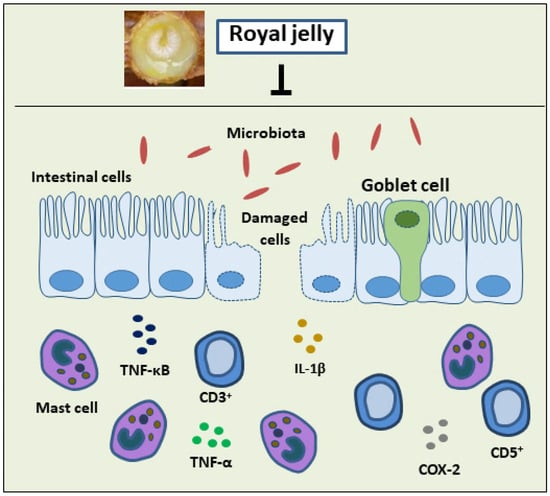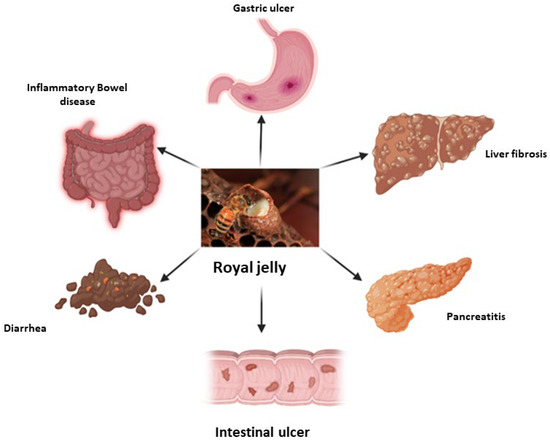Royal jelly (RJ), a natural bee product rich in bioactive components, as an alternative strategy for managing metabolic diseases. RJ exhibits diverse therapeutic properties, including antimicrobial, estrogen-like, anti-inflammatory, hypotensive, anticancer, and antioxidant effects.
1. Introduction
Royal jelly (RJ) is a “rich source of nutrients” that nurse bees produce and feed to worker larvae and queen bees. RJ supplementation is beneficial for a variety of disorders, including diabetes [1][2][11,12], gastrointestinal diseases [3][4][13,14], and cardiovascular diseases [5][6][15,16]. The active ingredients of RJ, including its proteins, carbohydrates, and fats, as well as its minerals, amino acids, vitamins, enzymes, hormones, and polyphenols, are what provide its biological properties [7][17].
Gastrointestinal disorders are common illnesses, including irritable bowel syndrome, peptic ulcers, liver diseases, pancreatitis, gallstones, and Crohn’s disease, and are often found in tropical regions
[8][65]. Sperber et al. (2021) estimated that 40% of the people in 33 countries across six continents have functional gastrointestinal problems
[9][66]. A strong link between gastrointestinal diseases and the diet of individuals in at-risk groups has been found. The dietary habits of people in the different areas contribute to the composition of their individual gut microbiota, and this is particularly noticeable when people move from urban to rural areas
[10][67]. According to Rizello et al. (2019), a westernized diet rich in carbohydrates and animal proteins is a main contributor to the development and progression of chronic inflammatory bowel disease
[11][68]. Due to involvement of the gastrointestinal tract in the absorption of nutrients, as well as its role in immune response, the risk of developing an inflammatory, autoimmune, chronic disease is inevitably increasing
[12][69].
RJ is considered one of the most important super foods, having displayed much biological activity in preclinical and clinical studies
[13][70]. As a honey bee product, it has been documented for its active potential against many disorders, including inflammation, liver disease, hypercholesterolemia, oxidative stress, and immune disease
[14][71]. RJ contains many bioactive compounds such as proteins, vitamins, phenolics, and flavonoids. Additional pharmaceutical studies have revealed that the bioactive, major protein constituents of RJ (MRJPs) are considered the main therapeutic compounds of those tested
[15][16][72,73].
2. Royal Jelly in Gastrointestinal Diseases
2.1. Inflammatory Bowel Diseases
Ulcerative colitis and Crohn’s disease are both chronic, inflammatory bowel illnesses. Inflammatory bowel disease describes a persistent, non-infectious inflammation with uncertain causes, affecting one or more locations in the digestive system. According to global estimations, the prevalence of inflammatory bowel disease accounted for approximately 7 million people in 2017
[17][74]. Hence, the exploration of natural product remedies would pave the way to natural and complementary tools for healing. For instance, the experimental induction of colon inflammation using 2,4,6-trinitrobenzene sulphonic acid was found to be significantly inhibited by the administration of RJ in mice at a dosage of 250 mg/kg/day for a week via the inhibition of pro-inflammatory cytokines, TNF-α, and interlukin-1β (IL-1β) along with the elevation of the anti-inflammatory cytokine interlukin-10 (IL-10)
[18][75]. Another study revealed that daily administration of RJ (150 mg/kg) considerably ameliorated the damage caused by acetic acid in rats with induced colitis, manifesting as decreased lesion areas in the colon where the intestinal mast cells were also involved in inflammation
[19][76]. Likewise, similar doses of RJ were found to reduce the proliferation of T-lymphocytes involved in the intestinal inflammation induced by acetic acid in rats
[20][77]. According to a recent study, synergism between RJ and selenium exhibits significant anti-inflammatory activity in inflammatory bowel disease in mice and promotes intestinal health through the improvement of the gut microbiota
[21][78].
The mechanism of RJ in treating inflammatory bowel syndrome has been reported by Guo et al. (2022) as shown on
Figure 13. The investigation revealed that RJ boosted the activity of the anti-inflammatory cytokine IL-10 and the intracellular antioxidant enzyme GPx. Additionally, RJ decreased the number of CD3+, CD5+, CD8+, and CD45+ T-cells, the release of TNF-αand the pro-inflammatory cytokines IL-1β, the nuclear factor Kappa-B (NF-κB), and cyclogenase-2 (COX-2) and tumor necrosis factor-induced injury in rats with colitis induced by 2,4,6-trinitrobenzene sulfonic acid
[22][79].
Figure 13. Treatment with royal jelly suppressed the rise of CD3+, CD5+, CD8+ and CD45+ T-cells, pro-inflammatory cytokines, IL-1β, TNF–α, and the expression of major inflammatory mediators (COX-2 and NF-κB) in the colon of rats with colitis. IL-1β: interleukin-1β; TNF-α: tumor necrosis factor-α; NF-κB: nuclear factor kappa-B; COX-2: cyclooxygenase-2.
2.2. Lactose Intolerance
Lactose intolerance is a gastrointestinal disorder that results from a lack of β-galactosidase, resulting in the maldigestion of lactose from milk and milk products. Patients with lactose intolerance present with symptoms such as pain in the abdomen, diarrhea, and flatulence, which appear after the intake of lactose-containing foods
[23][80]. Recently, researchers have found that the synergism between RJ and probiotic yogurt has potent activity in treating lactose intolerance
[24][81].
There is growing evidence that lactose intolerance symptoms can be treated with probiotic bacteria found in fermented and unfermented milk products
[25][82]. The mechanism of RJ in reducing lactose intolerance relies on the activity of probiotics delivered via fermented milk products, which have been found to play an important role in health benefits, as reported by Hassan et al. (2022). The fermentation of milk with 1% RJ displayed the presence of abundant probiotics, namely
Lactobacillus helveticus, which results in boosting the bioactive properties of fermented milk
[26][83].
2.3. Chronic Diarrhea and Constipation
The symptoms of chronic constipation include uncomfortable defecation, marked by straining and difficulty along with extended time in stool passage
[27][84]. Constipation in children is estimated to affect from 1% to 30% of the young generation worldwide
[28][85]. Compared to standard antiviral medication, honey has been shown to reduce the incidence and duration of viral diarrhea
[29][86]. As documented by Miyauchi-Wakuda et al. (2019), under in vitro circumstances, acetylcholine in RJ induced contractions of the smooth muscle of the mouse’s ilium via the muscarinic acetylcholine receptor, which was independent of nicotinic acetylcholine activity. The intake of royal jelly does not result in severe symptoms like diarrhea in normal situations
[4][30][14,87]. Further, the anti-diarrheal potency of RJ could be attributed to the antimicrobial activity of its peptide constituents, royalisin and royalactin
[31][32][88,89]. Even though RJ has a high concentration of acetylcholine, only one oral dose of RJ was not enough to boost intestinal motility or alleviate constipation.
2.4. Gastrointestinal Ulcer Disease
Gastric and intestinal ulcers induced by diclofenac (50 mg/kg) have been normalized using RJ at a dose of 150 mg/kg or 300 mg/kg via the increase of prostaglandin-2 (PGE-2) and COX-2 in the stomach tissues of mice, as well as reducing myeloperoxidase (MPO) and inducible nitric oxide synthase (iNOS)
[14][71]. Another study revealed that acetic acid-induced peptic ulcers in rats could be treated significantly using a daily dose of RJ (200 mg/kg), in comparison to the commonly used anti-ulcer drug omeprazole (20 mg/kg), for 14 days of treatment
[33][90]. Furthermore, when RJ was administered to rats at a dose of 250 mg/kg, it protected them from ulcers in the stomach caused by ethanol. This was relative to the ulcer-preventing medication, lansoprazole, given at a dose of 30 mg/kg. The mechanism of gastroprotection has been claimed to be due to the attenuation of pro-inflammatory cytokines, TNF-α, lipid peroxidation, and IL-1β in addition to the augmentation of the endogenous antioxidant enzyme SOD and CAT
[3][13]. El-Naeem and Fareed (2022) reported the positive effects of 30-day administration of RJ (300 mg/kg) on ameliorating the gastric mucosal histopathological changes that were caused in rats by intra-peritoneal injection of 0.5 mg nicotine tartarate
[34][91].
2.5. Liver Disease
2.5.1. Preclinical Studies
Synergistic, daily treatment of mice with the drug diclofenac (50 mg/kg) for seven days, following which RJ was given orally at dosages of 150/or 300 mg/kg for a month, was found to alleviate the hepato-renal toxicity of the drug through over-expression of PGE-2 and COX-2 in the animals’ liver and stomach tissues
[14][71]. The hepatic toxicity triggered by the immunosuppressive drug azathioprine was found to be altered by oral administration of RJ (200 mg/kg) in rats through the attenuation of the high levels of serum hepatic enzymes caused by an intra-peritoneal injection of 50 mg/kg dose of azathioprine
[35][92]. According to a recent study, feeding diabetic rats 300 mg/kg of RJ for 16 weeks, development of non-alcoholic fatty liver disease (NAFLD) was reported. The study concluded that RJ has anti-inflammatory and antioxidant properties that protect against NAFLD, while also regulating the metabolism of fatty acids such as arachidonic acid and linoleic acid as well as the production of unsaturated fatty acids
[36][93]. The study revealed that RJ treatment significantly raised the serum levels of adiponectin and concurrently raised the hepatic phosphorylation of 5’ adenosine monophosphate-activated protein kinase (AMPK). Where the hypolipidemic effect of RJ is mediated mainly by regulating AMPK, these effects have been noticed in rats that were fed a high-fat diet and subsequently developed NAFLD. RJ suggests a novel, independent mode of action by promoting fatty acid oxidation via activation of hepatic AMPK signaling and by suppressing cholesterol formation via sterol regulatory element-binding proteins SREBP1/2 without altering the production of adiponectin, the enzyme responsible for fatty acid oxidation, and lowering the synthesis of triglycerides and cholesterol
[36][37][93,94].
2.5.2. Clinical Studies
A further investigation found that administration of 1 g/day of RJ for 30 days to patients with chronic hepatitis B could influence the immunological responses of patients by inhibiting the protein responsible for initiating inflammatory responses, NLRP1. Additionally, RJ up-regulated the functions that the inflammasome adaptor speck-like protein (ASC) performs in modulating immune responses
[38][95]. Collectively, RJ was documented for its potent activity in treating gastrointestinal diseases as per in vitro and in vivo studies. The possible impact of RJ on various digestive tract illnesses is summarized in
Figure 24.
Figure 24.
Potential activity of royal jelly in the most common gastrointestinal diseases.


